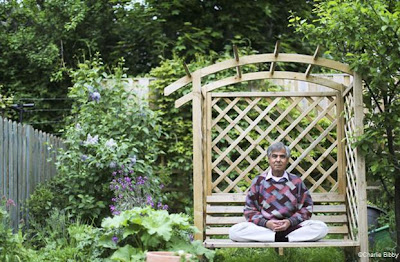The
Mitford sisters became notorious in the 1930s and 1940s as aristocratic socialites who pursued widely divergent political paths. Unity and Diana both became Hitler enthusiasts, the latter marrying British Union of Fascists leader Oswald Mosley.
Jessica Mitford (1917-1996) on the other hand ran away to Spain with her boyfriend Esmond Romilly to back the republic against Franco's fascist rebellion. Back in London and married, they ended up in 1937 living at 41 Rotherhithe Street in a large house 'wedged between warehouses' on the river. The house belonged to Roger Roughton (1916-1941), surrealist poet, who also stayed there. Another frequent guest was their friend the writer Philip Toynbee (Polly's dad). They held 'bottle parties... frequented by a motley crowd of journalists, writers, night-club singers, students' and spent a lot of time arguing about the merits of joining the Communist Party (Toynbee and Roughton did).
It's easy to mock the idea of a couple of upper class lefties slumming it in SE London, and indeed there is some condescension in Mitford's account: 'The bus ride from Rotherhithe to more familiar parts of London (Kensington, Hyde Park, Oxford Street) takes well over an hour. It winds past miles and miles of workers’ flats with such incongruous sounding names as Devon Mansions, Cornwall Homes. Five or six storeys high, these gloomy red-brick structures house a shorter and paler race of people than the inhabitants of London's West End. In appearance, dress and speech they form so radical a contrast as to give the impression of a different ethnic group'.
 |
According to a 2002 Southwark Council Rotherhithe history map the former 41 Rotherhithe Street is now on Fulford Street,
the 'sole remaining terraced house from a whole row lining Thames'. So pretty sure this is it - or it could have been one of the now demolished adjoining buildings, where the Londonphile notes John Betjeman, Marlene Dietrich, Lord Snowdon, Princess Margaret and Noel Coward variously hung out! |
Nevertheless, despite living in a comfortable house, Mitford and Romilly were largely cut off in disgrace from their family wealth and struggled to get by. To an extent they did share some of the life of local working class people, eating 'fish and chips at the nearest Lyons teashop' and getting involved in the local Labour Party:
'The Bermondsey Labour Party was much more to our liking. At the monthly meetings, held in a shabby hall not far from Rotherhithe Street, vigorous discussions would take place on the important political events of the day. Tired, white-faced dockers and their wives would join in "The Red Flag", a popular Labour Party anthem in that part of London. Fund-raising campaigns for milk for Spanish orphans or for aid to Hitler’s Jewish victims were planned and carried out, often in defiance of the wishes of Transport House [Labour Party national HQ]. If they lacked the glamour and the special, high-flown language of some of our Communist friends, these members of the local Labour Party branch seemed to display a seriousness of purpose and a down-to-earth understanding of issues that quickly won our respect. The Labour Party in that section of London was considerably more militant than the Party's official spokesmen. It was said that the schoolchildren lined up to boo Princess Mary, symbol of hated charity, when she made her infrequent expeditions to the local orphanage.
On May Day the entire community turned out, men, women and children, home-made banners proclaiming slogans of the "United Front against Fascism" waving alongside the official ones. The long march to Hyde Park started early in the morning, contingents of the Labour Party, the Co-ops, the Communist Party, the Independent Labour Party marching through the long day... Everyone took lunch in a paper bag, and there was much good-natured jostling and shouting of orders, and last-minute rounding up of children who had darted away in the crowd. Philip and Roger taught us some new songs to sing on the way- parodies on Communist songs: “Class conscious we are, and class conscious we’ll be, And we'll tread on the necks of the the bourgeoisie !”, "Oh, ’tis my delight, of a dirty night to bomb the bourgeoisie!”, and a sarcastic version of "The People's Flag": "The People's flag is palest pink, It's not as red as you might think."
We had been warned that the Blackshirts might try to disrupt the parade, and sure enough there were groups of them lying in wait at points along the way. Armed with rubber truncheons and knuckle-dusters, they leaped out from behind buildings; there were several brief battles in which the Blackshirts were overwhelmed by the sheer numbers of the Bermondsey men'.
Sadly, they shared another feature of local life - the tragedy of infant mortality. In December 1937, Mitford gave birth to a daughter, Julia: 'She became the centre of my existence. Esmond gleefully watched her grow, learn to smile, learn to wave her feet and catch them with an unsteady hand. We planned her future, growing up among the rough children of Rotherhithe Street, born to freedom and May Day parades, without the irksome restraints of nanny, governess, daily walks and dull dances'. Within six months however the baby had died in a measles epidemic.
Later in 1938 they were forced to move out of Rotherhithe Street when they couldn't afford to pay their electricity bill, and the following year they moved to the United States. During the Second World War Romilly, who had fought with the International Brigades as a teenager in Spain, joined the Royal Canadian Air Force. He was killed in action in 1941. In the same year, Roughton committed suicide in the midst of despair about the Nazi-Soviet pact. Mitford remained in the United States where she lived a long and fruitful life as a writer and civil rights activist.
 |
| Esmond Romilly and Jessica Mitford |
Source: Hons and Rebels - Jessica Mitford, 1960









































